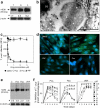Structural insights into inhibition of sterol 14alpha-demethylase in the human pathogen Trypanosoma cruzi
- PMID: 20530488
- PMCID: PMC2919122
- DOI: 10.1074/jbc.M110.133215
Structural insights into inhibition of sterol 14alpha-demethylase in the human pathogen Trypanosoma cruzi
Abstract
Trypanosoma cruzi causes Chagas disease (American trypanosomiasis), which threatens the lives of millions of people and remains incurable in its chronic stage. The antifungal drug posaconazole that blocks sterol biosynthesis in the parasite is the only compound entering clinical trials for the chronic form of this infection. Crystal structures of the drug target enzyme, Trypanosoma cruzi sterol 14alpha-demethylase (CYP51), complexed with posaconazole, another antifungal agent fluconazole and an experimental inhibitor, (R)-4'-chloro-N-(1-(2,4-dichlorophenyl)-2-(1H-imid-azol-1-yl)ethyl)biphenyl-4-carboxamide (VNF), allow prediction of important chemical features that enhance the drug potencies. Combined with comparative analysis of inhibitor binding parameters, influence on the catalytic activity of the trypanosomal enzyme and its human counterpart, and their cellular effects at different stages of the Trypanosoma cruzi life cycle, the structural data provide a molecular background to CYP51 inhibition and azole resistance and enlighten the path for directed design of new, more potent and selective drugs to develop an efficient treatment for Chagas disease.
Figures






Similar articles
-
Complexes of Trypanosoma cruzi sterol 14α-demethylase (CYP51) with two pyridine-based drug candidates for Chagas disease: structural basis for pathogen selectivity.J Biol Chem. 2013 Nov 1;288(44):31602-15. doi: 10.1074/jbc.M113.497990. Epub 2013 Sep 18. J Biol Chem. 2013. PMID: 24047900 Free PMC article.
-
Targeting Trypanosoma cruzi sterol 14α-demethylase (CYP51).Adv Parasitol. 2011;75:65-87. doi: 10.1016/B978-0-12-385863-4.00004-6. Adv Parasitol. 2011. PMID: 21820552 Free PMC article. Review.
-
Structural characterization of CYP51 from Trypanosoma cruzi and Trypanosoma brucei bound to the antifungal drugs posaconazole and fluconazole.PLoS Negl Trop Dis. 2010 Apr 6;4(4):e651. doi: 10.1371/journal.pntd.0000651. PLoS Negl Trop Dis. 2010. PMID: 20386598 Free PMC article.
-
Pharmacological characterization, structural studies, and in vivo activities of anti-Chagas disease lead compounds derived from tipifarnib.Antimicrob Agents Chemother. 2012 Sep;56(9):4914-21. doi: 10.1128/AAC.06244-11. Epub 2012 Jul 9. Antimicrob Agents Chemother. 2012. PMID: 22777048 Free PMC article.
-
Sterol 14-demethylase inhibitors for Trypanosoma cruzi infections.Adv Exp Med Biol. 2008;625:61-80. doi: 10.1007/978-0-387-77570-8_6. Adv Exp Med Biol. 2008. PMID: 18365659 Review.
Cited by
-
Organocatalytic, enantioselective synthesis of VNI: a robust therapeutic development platform for Chagas, a neglected tropical disease.Org Lett. 2012 Dec 21;14(24):6322-5. doi: 10.1021/ol303092v. Epub 2012 Dec 7. Org Lett. 2012. PMID: 23214987 Free PMC article.
-
Planning new Trypanosoma cruzi CYP51 inhibitors using QSAR studies.Mol Divers. 2021 Nov;25(4):2219-2235. doi: 10.1007/s11030-020-10113-2. Epub 2020 Jun 16. Mol Divers. 2021. PMID: 32557280
-
Design or screening of drugs for the treatment of Chagas disease: what shows the most promise?Expert Opin Drug Discov. 2013 Dec;8(12):1479-89. doi: 10.1517/17460441.2013.845554. Epub 2013 Sep 30. Expert Opin Drug Discov. 2013. PMID: 24079515 Free PMC article. Review.
-
Immunization with Hexon modified adenoviral vectors integrated with gp83 epitope provides protection against Trypanosoma cruzi infection.PLoS Negl Trop Dis. 2014 Aug 21;8(8):e3089. doi: 10.1371/journal.pntd.0003089. eCollection 2014 Aug. PLoS Negl Trop Dis. 2014. PMID: 25144771 Free PMC article.
-
Cloning, expression, purification and spectrophotometric analysis of lanosterol 14-alpha demethylase from Leishmania braziliensis (LbCYP51).Mol Biol Rep. 2018 Apr;45(2):175-183. doi: 10.1007/s11033-018-4150-7. Epub 2018 Jan 23. Mol Biol Rep. 2018. PMID: 29363024
References
-
- Moncayo A., Silveira A. C. (2009) Mem. Inst. Oswaldo Cruz. 104, 17–30 - PubMed
-
- Neva F. A. (2007) Cecil Medicine:Expert Consult, Ch. 368, 23rd Ed., Saunders Elsevier, Philadelphia
-
- Schmunis G. A. (2007) Mem. Inst. Oswaldo Cruz. 102, 75–85 - PubMed
-
- Gonzalez-Granado L. I., Rojo-Conejo P., Ruiz-Contreras J., Gonzalez-Tomé M. I. (2009) Lancet 373, 2025. - PubMed
Publication types
MeSH terms
Substances
Associated data
- Actions
- Actions
- Actions
Grants and funding
LinkOut - more resources
Full Text Sources

